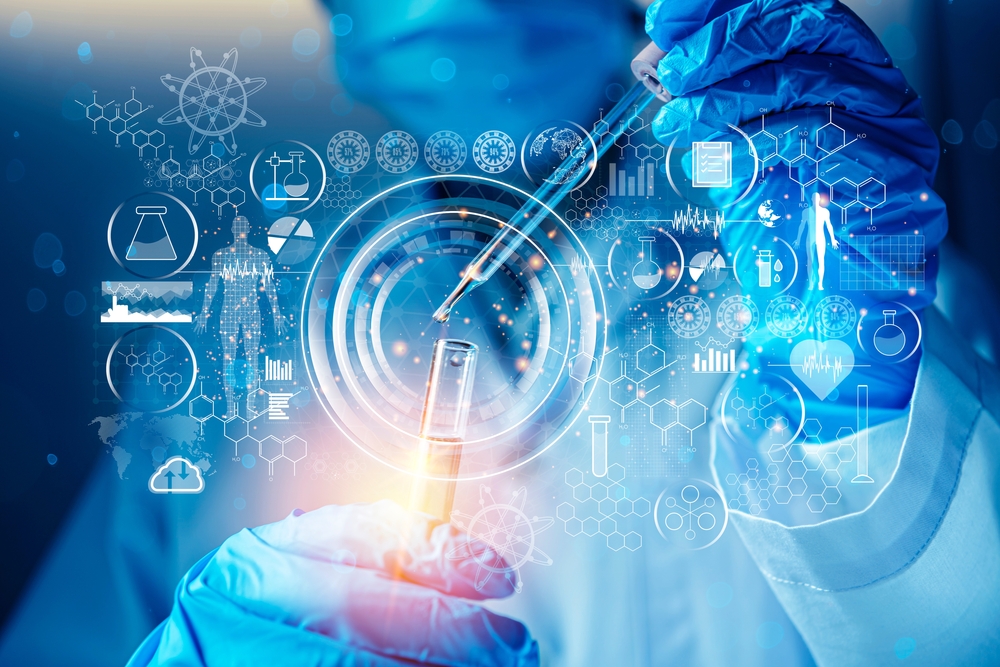
In the dynamic landscape of the biotech industry, the establishment of a wet lab marks a pivotal step for startups seeking to innovate, research, and contribute to scientific advancements. As the biotech sector continues its rapid evolution, the foundation of a well-designed and equipped wet lab becomes a cornerstone for success.
The path of a biotech start-up company is shaped by every aspect, from navigating the complexities of business strategy and securing funding to sprucing up the lab space. In this article, we delve into essential tips for startups venturing into the biotech realm, with a particular focus on the design and equipping of wet labs.
As we explore the intricacies of creating a functional and efficient workspace, we’ll also touch on key considerations in business planning, securing funding, selecting an optimal location, and managing the day-to-day operations of a biotech lab.
What is a Biotech Lab?
A biotechnology laboratory is a specialized facility equipped for conducting research, experimentation, and development activities in the field of biotechnology.
Biotechnology encompasses the application of biological and molecular techniques to develop products, processes, or technologies that benefit various industries, including medicine, agriculture, and environmental science.
Biotech labs are vital in advancing scientific understanding, generating fresh biotechnological applications, and contributing to breakthroughs that address real-world issues.
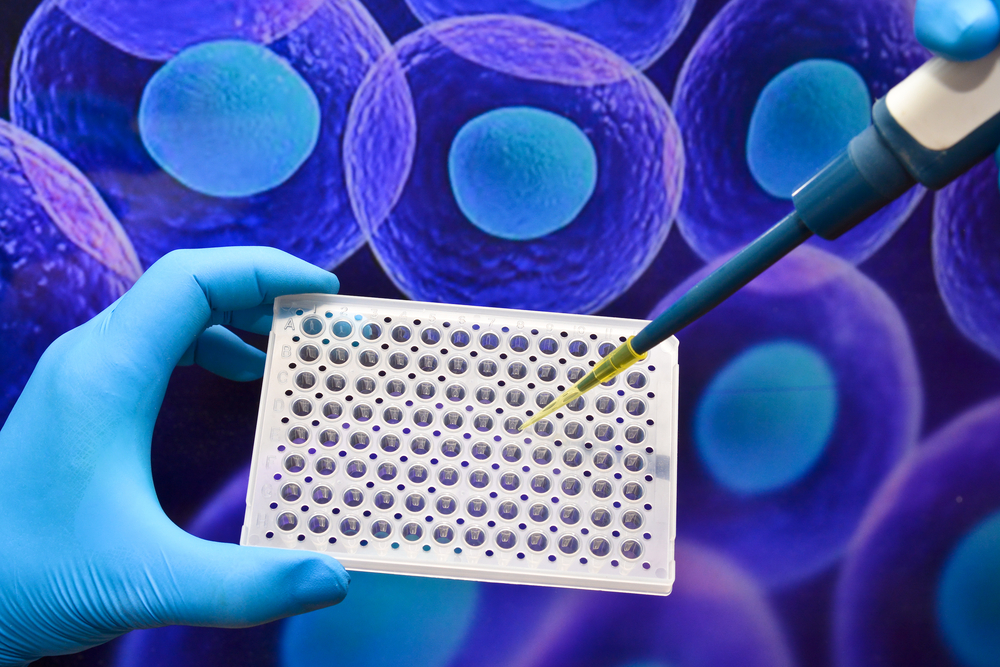
Key features and activities within wet labs in the biotech industry include:
- Research and Development (R&D): Biotech labs are dedicated to researching to understand biological processes, manipulate genetic material, and develop new technologies or products.
- Cell Culture: Many biotech labs are equipped for cell culture, involving the cultivation and manipulation of cells for various applications, such as producing recombinant proteins or studying cell behavior.
- Molecular Biology: Labs in this field often engage in molecular biology experiments, including DNA and RNA analysis, gene expression studies, PCR (Polymerase Chain Reaction), and genetic engineering.
- Biochemical Analyses: Biotech labs frequently perform biochemical analyses, studying the structure and function of biomolecules like proteins, enzymes, and metabolites.
- Genetic Engineering: Genetic manipulation and engineering are common activities in biotech labs, involving the modification of organisms’ genetic material to achieve specific outcomes.
- Drug Discovery and Development: Pharma labs focus on drug discovery, screening compounds for potential therapeutic use, and developing pharmaceuticals. These labs are often involved in clinical trials.
- Agricultural Biotechnology: Labs in this field may work on genetically modified organisms (GMOs), crop improvement, and developing sustainable agricultural practices.
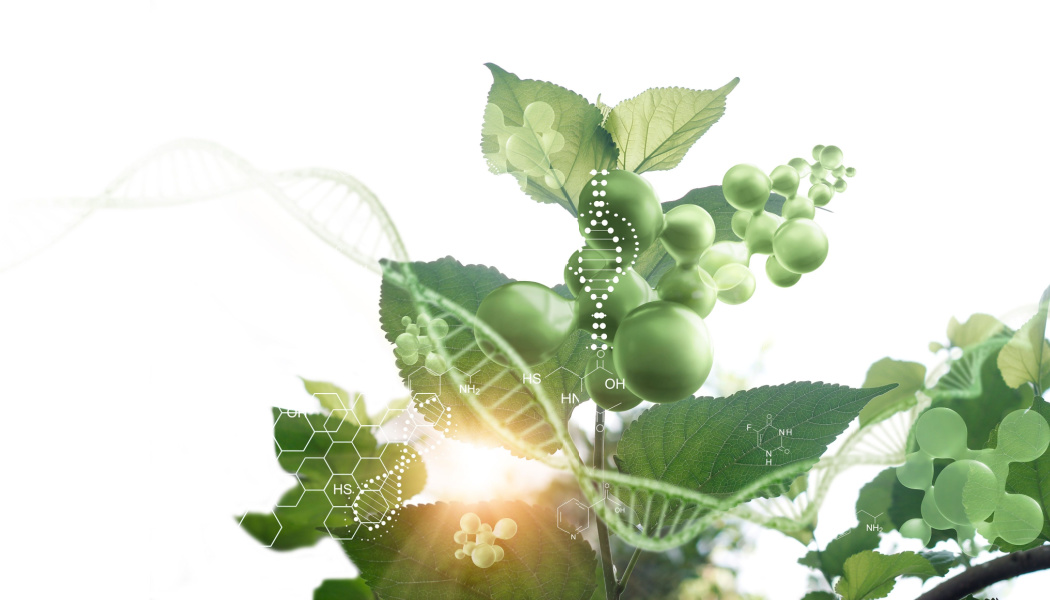
- Environmental Biotechnology: Biotech labs may engage in environmental research, developing solutions for waste treatment, pollution control, and environmental conservation.
- Bioprocessing and Fermentation: Labs may be equipped for bioprocessing, involving the large-scale production of biotechnological products through fermentation or other bio-based methods.
- Biomedical Research: Biotech labs often contribute to biomedical research, studying diseases, developing diagnostic tools, and exploring therapeutic interventions.
- Bioinformatics: Some labs integrate bioinformatics, involving the use of computational tools and data analysis, to interpret biological information and conduct systems biology research.
The design of a biotech lab involves careful consideration of the specific research needs, safety requirements, and regulatory compliance. The facility typically includes specialized equipment, controlled environmental conditions, and dedicated areas for different research activities.
Biotech labs are essential hubs for advancing scientific knowledge and translating discoveries into practical applications to benefit society.
Factors to Consider for a Startup Biotech Lab
Designing a wet lab for a biotech startup involves careful planning to ensure the facility is well-equipped, safe, and conducive to efficient research and development activities. Here are key considerations to keep in mind:
Planning

The planning of establishing a wet lab space in the biotech sector involves several early-stage steps before the laboratory’s construction can begin. The following basic steps form the groundwork for a successful startup lab:
1. Research Focus and Goals
Clearly define the research focus and goals of the biotech startup. The lab design should accommodate the specific needs of the research activities. Biotechnology is an interdisciplinary subject that covers topics such as biochemistry, genetics, cell biology, embryology, molecular biology, chemical engineering, and robotics.
2. Create a Detailed Business Plan
Develop a comprehensive business plan outlining your laboratory’s mission, objectives, budget, and projected timelines. It should include market research, findings, and conclusions to demonstrate knowledge of your industry and market. This will be crucial for attracting investors and guiding your operations.
3. Secure Funding
Biotech laboratories require a significant financial investment. Explore funding options such as grants, venture capital, private investors, government funding, or partnerships.
4. Select an Appropriate Location
Choose a location that meets the specific needs of a biotech laboratory. Consider factors like proximity to research institutions, and access to skilled personnel.
Consider locating the lab near universities and research centers to tap into a pool of skilled researchers and potential collaborators.
Ensuring the availability of necessary infrastructure such as lab facilities, adequate utilities, and support services is also important.
5. Compliance and Regulations
Familiarize yourself with local, national, and international regulations governing biotech research. Ensure that your chosen location allows compliance with ethical standards, safety protocols, and legal requirements.
Obtain any necessary permits or approvals. Establish a relationship with regulatory agencies or consultants to ensure ongoing compliance and to stay informed about any regulatory changes that may impact the lab.
6. Budgeting
Develop a detailed budget that includes not only the initial setup costs but also ongoing operational expenses. Prioritize essential furniture, equipment, and infrastructure while considering cost-effective solutions.
Lab Space and Layout
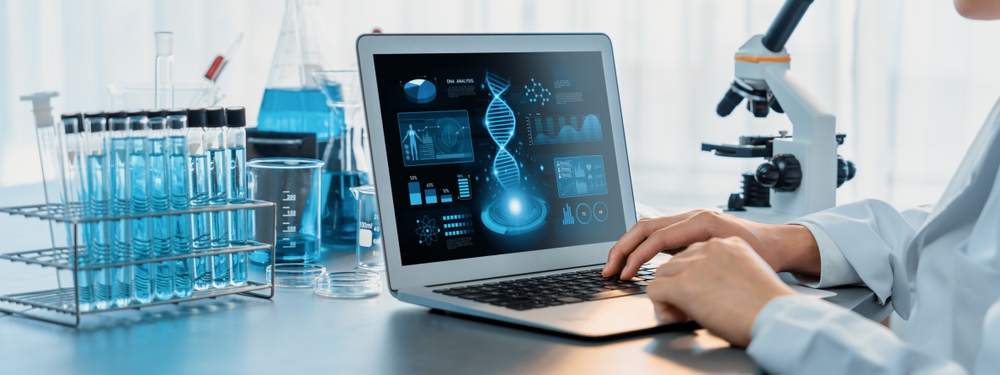
Plan the lab layout to optimize workflow, efficiency, and safety. Consider the spatial requirements of different workstations, equipment, and storage areas. Provide ample bench space and design the layout to prevent cross-contamination. Include factors like ventilation, emergency exits, and waste disposal.
Designing a biotech lab involves careful planning to create distinct zones that cater to specific activities, ensuring a well-organized and functional workspace. While the specific layout may vary depending on the lab’s focus and size, here are several key zones to consider:
1. Laboratory Work Area
This is the primary zone where experimental work and research activities take place. It includes workbenches, fume hoods, and specialized equipment for tasks such as cell culture, molecular biology, and biochemical analyses. The layout should facilitate efficient workflow and minimize the risk of contamination.
2. Instrumentation Area
Dedicate a zone for analytical instruments and equipment used for data analysis and sample processing. This may include mass spectrometers, PCR machines, spectrophotometers, and other specialized instruments. Ensure proper spacing and access for maintenance.
3. Chemical Storage and Preparation Area
Create a designated area for storing and preparing chemicals. Include chemical storage cabinets, fume hoods, and safety equipment. Ensure proper ventilation and segregation of incompatible chemicals to enhance safety.
4. Cold Storage Zone
Allocate space for refrigerators and freezers for storing reagents, samples, and biological materials at specific temperatures. Consider different temperature zones, such as -20 °C, -80 °C, and liquid nitrogen storage for long-term sample preservation.
5. Waste Management Area
Designate an area for waste disposal, including bins for general waste, recyclables, and hazardous waste. Ensure proper labeling, segregation, and compliance with waste disposal regulations. This area may also include autoclaves for sterilizing waste.
6. Tissue Culture Room
If cell culture is a significant part of the research, create a dedicated tissue culture room. Provide laminar flow hoods, incubators, and other equipment needed for aseptic cell culture work. Control access to minimize the risk of contamination.
7. Prep and Wash Area
Include a zone for preparing solutions, washing glassware, and carrying out preliminary tasks. This area may have sinks, glassware drying racks, and space for preparing reagents. Adequate ventilation and easy access to water sources are essential.
8. Office and Data Analysis Area
Allocate space for offices or workstations dedicated to data analysis, literature review, and administrative tasks. This office space may include computers, printers, and other office equipment. Proximity to the laboratory work area can facilitate collaboration.
9. Safety Equipment and Emergency Response Zone
Designate an area for safety equipment, such as eye wash stations, emergency showers, first aid kits, and fire extinguishers. Ensure that this zone is easily accessible and visible, promoting a quick response in case of emergencies.
10. Storage and Glassware Cleaning Area
Create a storage area for glassware and clean glassware washing stations. Include drying racks, dishwashers, and other equipment needed for maintaining clean and sterile glassware.
11. Utility and Service Zone
Plan for utility connections, service access, and maintenance space. This zone may house utility panels, electrical connections, and services such as gas, water, and ventilation systems.
12. Collaboration Spaces
Integrate collaboration spaces within the lab design, such as meeting rooms, discussion areas, or communal spaces. These areas promote teamwork, communication, and idea exchange among researchers and coworkers. This can foster a collaborative and innovative research environment.
13. Entrance and Reception Area
Design a welcoming entrance and reception area to create a positive first impression. Provide storage for personal items, a check-in system for visitors, and information about safety protocols.
14. Training and Education Zone
Allocate a space for training sessions, workshops, or educational activities. This area can be equipped with multimedia tools and interactive displays to facilitate training programs for lab personnel.
15. Future Expansion Space
Design the lab with flexibility and scalability in mind to accommodate changes in research focus or technology. Plan for scalability to accommodate future growth, additional equipment, and an expanding research team.
The design for a startup wet lab should be flexible, allowing for adaptability as research priorities evolve and technologies change. Once up and running, regularly review and update the lab design to meet the evolving needs of the biotech research conducted in the facility. Additionally, ensure compliance with safety and regulatory standards throughout the lab design and layout.
Furniture Selection for a Startup Biotech Lab
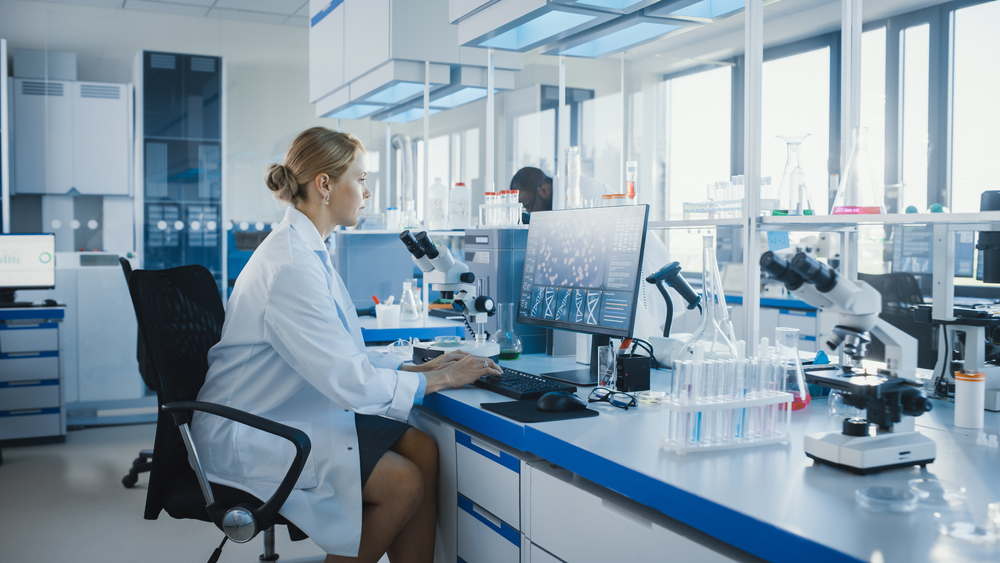
Choosing appropriate furniture and fixtures for a new lab is crucial for creating a functional, safe, and efficient workspace. Here are some of the aspects to consider when selecting furniture for your biotech lab:
1. Material and Durability
Choose furniture made of durable and chemical-resistant materials. Given the nature of biotech experiments involving various chemicals, the furniture should withstand exposure to acids, bases, solvents, and other potentially corrosive substances.
2. Ergonomics
Prioritize ergonomic design to ensure the comfort and well-being of laboratory personnel. Adjustable-height workbenches and chairs provide flexibility for different tasks and accommodate researchers of varying heights. This is helpful for tasks that involve prolonged periods of sitting or standing. Ergonomic furniture contributes to a comfortable and safe working environment, reducing the risk of strain or injury.
3. Adaptability and Flexibility
Some biotech labs opt for customizable lab furniture to meet specific requirements. This may include workstations with integrated power and data connections, modular casework that can be easily reconfigured, and specialized storage solutions tailored to the lab’s needs. This is particularly important as research projects evolve, and new equipment or processes may be introduced.
4. Workbench Design
Choose workbenches that offer sufficient workspace and are designed for the specific needs of the lab. Consider features such as built-in storage, electrical outlets, and modular configurations to enhance functionality.
5. Anti-Vibration Tables
For sensitive equipment, such as microscopes or precision instruments, consider anti-vibration tables to minimize vibrations that could impact experimental results.
6. Ventilation Systems
Laboratory ventilation systems should be carefully considered, including both exhaust and supply duct systems. The purpose of a laboratory exhaust system is to exhaust a specific volume of air from laboratory fume hoods or other exhaust devices.
The contaminated air is then safely transported from the building in a manner that reduces the potential for re-entrainment of exhaust fumes into the fresh air intake in the building.
7. Temperature and Environmental Control
Incorporate systems for precise temperature control and environmental monitoring. This is especially important for experiments involving cell culture, enzymatic reactions, and other processes sensitive to temperature variations.
8. Electrical and Data Access
Incorporate furniture with built-in electrical outlets and data ports to support the use of electronic equipment, computers, and other devices. Proper cable management is essential for safety and organization.
9. Ease of Cleaning
Choose furniture that is easy to clean and sanitize. Smooth surfaces without seams or crevices minimize the risk of microbial contamination, and materials should withstand regular cleaning with disinfectants.
10. Safety Features
Ensure that the furniture complies with safety standards and includes features such as rounded edges to prevent injuries. Ensure that the selected furniture complies with regulatory standards and guidelines. This includes safety regulations and any specific requirements for the storage of hazardous materials.
11. Supplier Reputation
Choose reputable suppliers with experience in providing lab furniture. Consider their accreditation, track record, customer reviews, and the availability of warranties or service agreements. Furthermore, your chosen supplier’s service would likely include expert guidance for startups setting up biotech labs.
Specialized Casework and Storage Cabinets for Biotech Labs
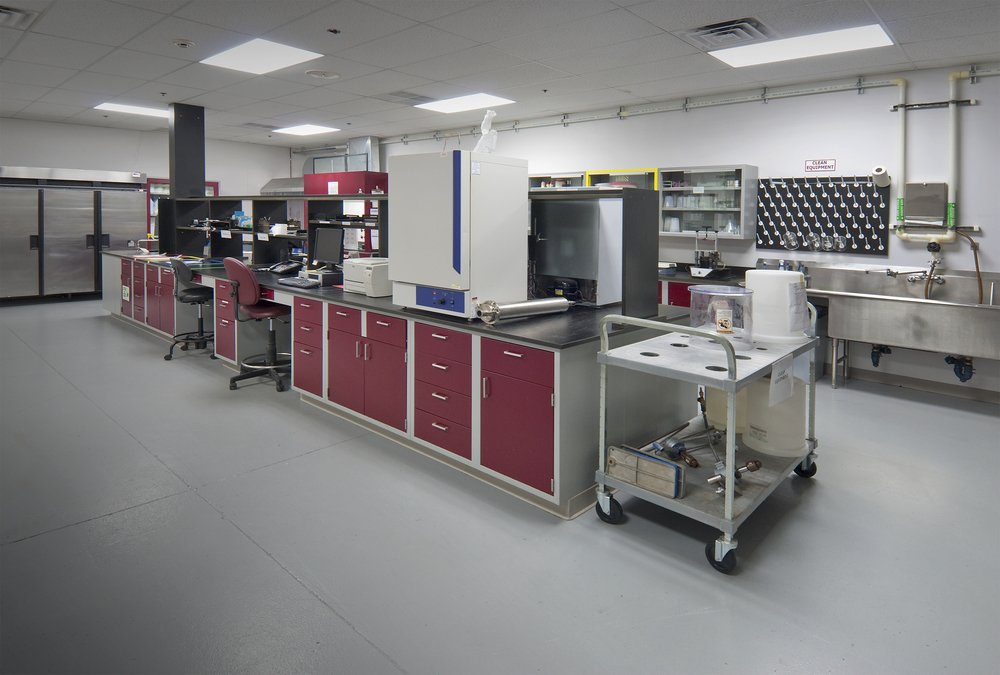
Specialized casework and storage cabinets are designed for specific needs in biotech labs, beyond the standard casework and storage typically found in wet labs. These specialized solutions are tailored to the unique requirements of biotechnology research, which often involves the use of sensitive instruments, specialized equipment, and hazardous materials. Here are some examples:
1. PCR Workstations
PCR workstations are designed to provide a clean and controlled environment for polymerase chain reaction (PCR) setup. These workstations often feature a HEPA-filtered air circulation system to maintain a sterile environment, preventing contamination in sensitive DNA amplification processes.
2. Hazardous Material Storage Cabinets
For labs dealing with hazardous materials, such as chemicals or radioactive substances, specialized storage cabinets are available. These cabinets are designed to meet safety and regulatory requirements for storing and segregating hazardous materials.
3. Flammable Storage Cabinets
Labs working with flammable liquids require storage solutions that comply with safety standards. Flammable storage cabinets are built with fire-resistant materials and feature ventilation systems to ensure the safe storage of flammable materials.
4. Cryogenic Storage Systems
Biotech labs involved in the storage of biological samples at extremely low temperatures often use cryogenic storage systems. These systems include specialized cabinets, racks, and containers designed for the secure storage of samples in liquid nitrogen or other cryogenic fluids.
5. Glove Box Enclosures
Glove box enclosures are used for handling sensitive materials or conducting experiments in a controlled atmosphere. They provide a sealed environment, often with built-in gloves for manipulation, and can be customized to accommodate specific research needs.
6. Biological Safety Cabinets (BSC)
Biosafety cabinets are crucial for working with biohazardous materials, such as microorganisms. They provide a sterile environment and protect researchers from potential exposure. BSCs come in different classes (Class I, II, and III) based on the level of containment required.
7. Radioisotope Storage Cabinets
Labs working with radioactive materials require storage solutions that shield against radiation. Radioisotope storage cabinets are designed with lead shielding to minimize the risk of exposure and contamination.
8. Equipment Enclosures
For sensitive equipment that requires controlled environmental conditions, equipment enclosures can be custom-built to provide protection from dust, contaminants, and temperature fluctuations.
9. Mobile Storage Systems
Mobile storage systems, such as compact shelving or rolling cabinets, offer efficient space utilization in biotech labs where space optimization is crucial. These systems can be customized to store various materials, from lab supplies to specialized equipment.
When planning the casework and storage solutions for a biotech lab, it’s essential to assess the specific needs of the research being conducted and to comply with safety and regulatory standards.
Customized solutions may be necessary to accommodate the unique requirements of the lab’s activities and equipment. Working with experienced lab design professionals can help ensure that the casework and storage solutions are tailored to the specific needs of the biotech research conducted in the facility.
Surface Material Selection

Work surfaces in a biotech lab play a crucial role in supporting various laboratory activities, from sample preparation to equipment setup. These surfaces need to meet specific requirements to ensure safety, cleanliness, and functionality. Here are some key considerations for tables, workstations, and other work surfaces in a biotech lab:
1. Chemical Resistance
The surfaces of lab benches should be highly resistant to chemicals, including acids, bases, solvents, and other reagents commonly used in biotech laboratories. Materials such as epoxy resin, phenolic resin, or chemical-resistant laminate are commonly chosen for their durability and resistance to chemical corrosion.
2. Smooth and Non-porous
Work surfaces should be smooth and non-porous to prevent the absorption of liquids and facilitate easy cleaning and decontamination. Non-porous surfaces help minimize the risk of microbial growth and maintain a sterile environment.
3. Durability
Choose durable materials that can withstand heavy usage, frequent cleaning, and potential impact from laboratory equipment. This ensures a longer lifespan for the work surfaces, reducing the need for frequent replacements.
4. Resistance to Heat and Cold
Depending on the lab’s activities, work surfaces may need to withstand exposure to extreme temperatures. Materials with resistance to both high and low temperatures are essential for maintaining the integrity of the work surface.
5. Electrical Conductivity and Static Control
In certain lab settings, especially those involving sensitive electronic equipment or sensitive experiments, work surfaces with low electrical conductivity or static control may be preferred to minimize the risk of electrostatic discharge
6. Antimicrobial Properties
Some labs may choose work surfaces with antimicrobial properties to inhibit the growth of microorganisms on the surface. This is particularly important in areas where maintaining a sterile environment is critical.
7. Radiation Resistance
In labs working with radioactive materials, work surfaces with resistance to radiation may be necessary. These surfaces help prevent damage and contamination caused by exposure to radioactive substances.
8. Compatibility with Lab Equipment
Work surfaces should be compatible with the installation of laboratory equipment such as microscopes, balances, and centrifuges. Consider the weight-bearing capacity and design of work surfaces to accommodate equipment securely.
9. Seamless Construction
Work surfaces should be constructed without seams or joints wherever possible. Seamless surfaces are easier to clean and minimize the risk of contamination or microbial growth in crevices. Work surfaces should be easy to clean and sanitize. Smooth, non-absorbent materials facilitate quick and effective cleaning, helping maintain a sterile and safe laboratory environment.
Ensure that the chosen work surfaces comply with relevant bioscience safety and environmental regulations, including guidelines for chemical resistance, material safety, and other industry standards.
Specialized Equipment for Biotech Labs
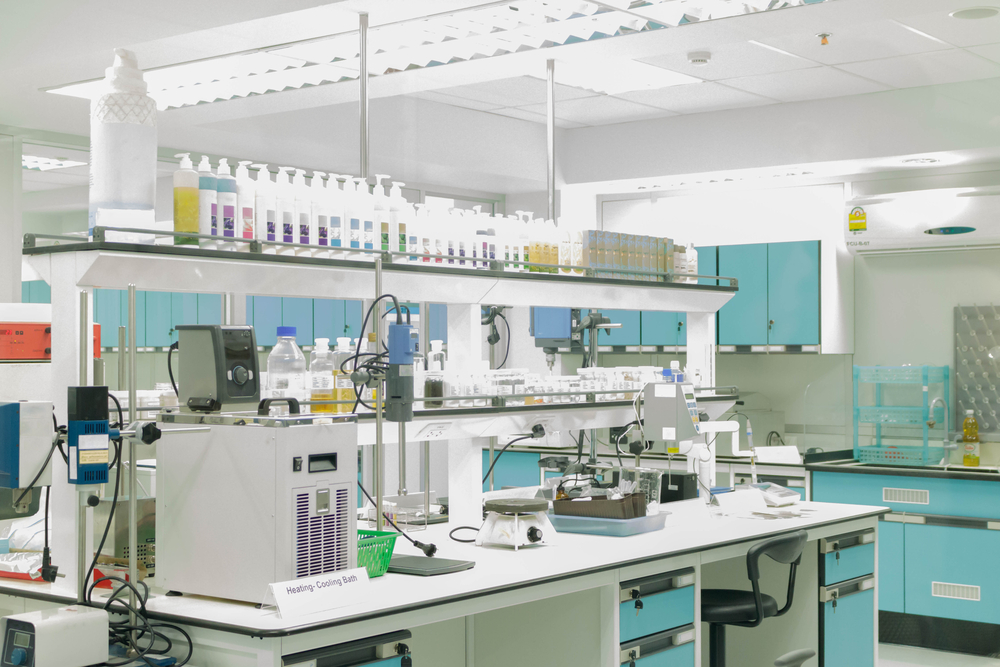
Biotechnology labs rely on various specialized equipment to conduct experiments, analyze samples, and carry out various processes. Invest in high-quality and reliable equipment that aligns with the startup’s research goals. Important types of equipment commonly used in biotechnology include the following:
1. Wet Lab Incubator
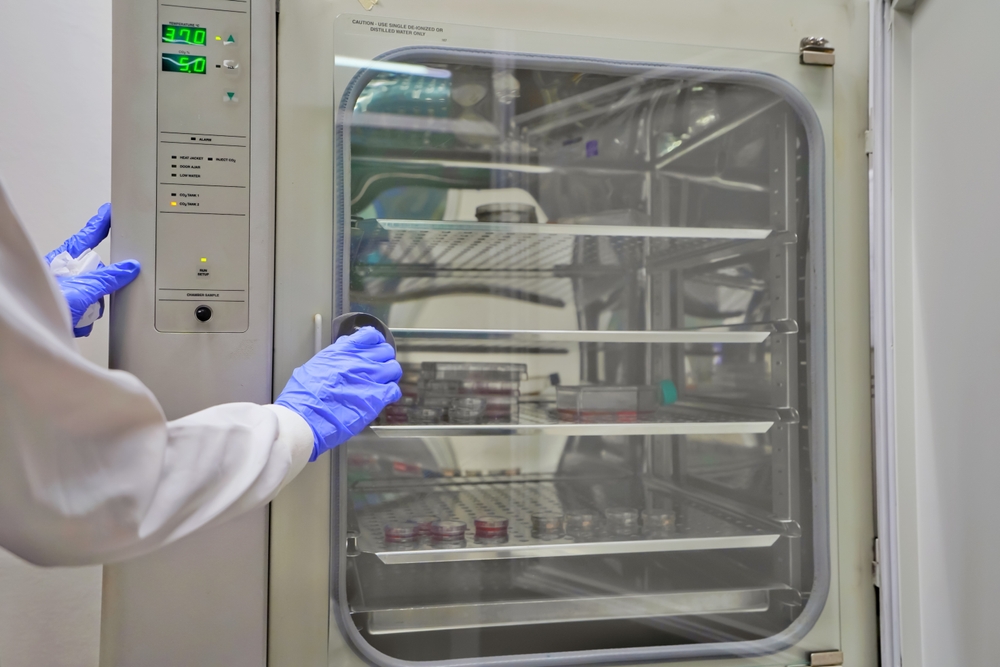
A wet lab incubator is a specialized piece of equipment that is essential for any life science company. It is designed to provide controlled environmental conditions for the incubation of biological samples or experiments.
When selecting a wet lab incubator, it’s crucial to match the features of the incubator to the specific requirements of your experiments or applications, whether it be cell culture, microbiology, or other biological processes.
Regular maintenance and calibration are also important to ensure the reliability and accuracy of the incubator over time.
2. PCR Machine (Polymerase Chain Reaction)
PCR machines are essential for amplifying DNA or RNA sequences through repeated cycles of denaturation, annealing, and extension. This technology is widely used in molecular biology for applications such as DNA sequencing, gene expression analysis, and genotyping.
3. Centrifuge
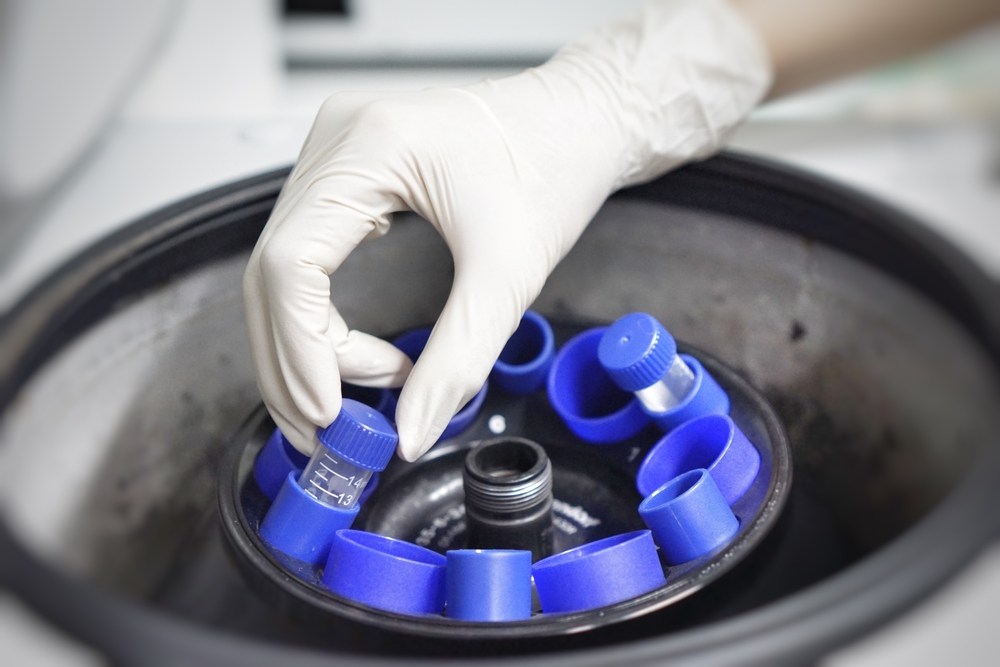
Centrifuges are used to separate components of a liquid mixture based on their density and buoyancy. They are crucial for tasks such as cell and organelle isolation, DNA/RNA purification, and the separation of proteins.
Different types of centrifuges (microcentrifuges, refrigerated centrifuges, ultracentrifuges) are employed depending on the specific requirements of the experiment.
4. Flow Cytometer
Flow cytometers are instruments used to analyze and sort individual cells or particles based on various physical and chemical characteristics. They are commonly used in cell biology and immunology for cell counting, cell cycle analysis, and fluorescence-activated cell sorting (FACS). Flow cytometry allows researchers to examine heterogeneous cell populations in detail.
5. Mass Spectrometer
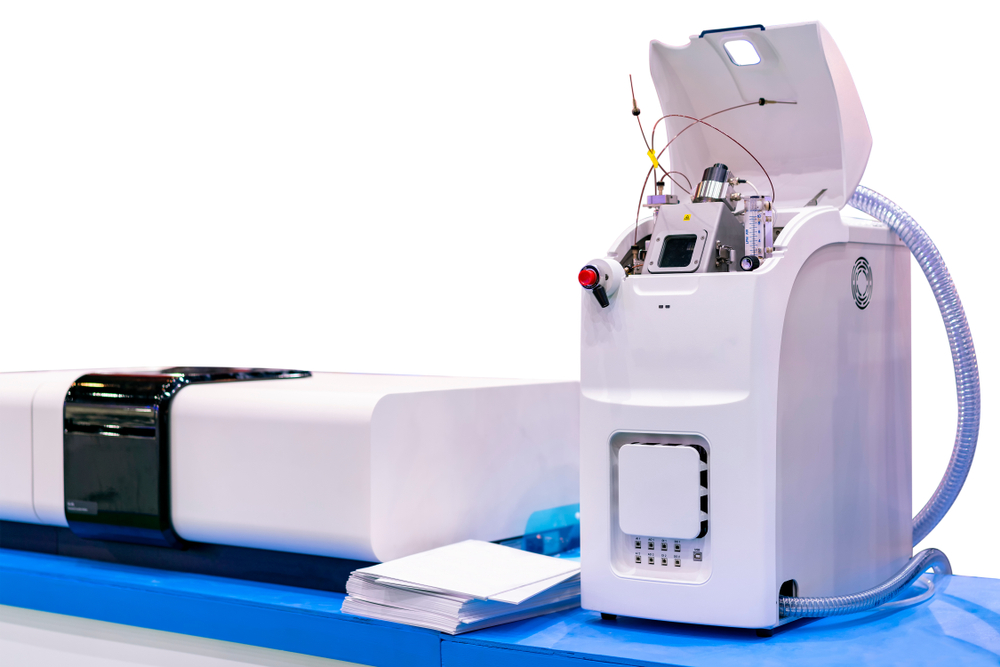
Mass spectrometers are analytical instruments that identify and quantify molecules based on their mass-to-charge ratio. In biotechnology, mass spectrometry is frequently used for protein identification, peptide sequencing, and metabolomics studies. It can provide valuable information about the composition and structure of biomolecules.
6. Liquid Chromatography System
Liquid chromatography systems are used to separate and analyze complex mixtures of compounds in a liquid sample. In biotechnology, liquid chromatography is often coupled with mass spectrometry (LC-MS) for the identification and quantification of biomolecules such as proteins, peptides, and metabolites. High-performance liquid chromatography (HPLC) and ultra-high-performance liquid chromatography (UHPLC) are common variants.
7. Autoclave
Autoclaves are high-pressure sterilization devices used in laboratories and medical settings, employing steam and heat to kill microorganisms. This ensures the sterility of equipment, media, and supplies for safe experimentation and patient care.
8. Bioreactors
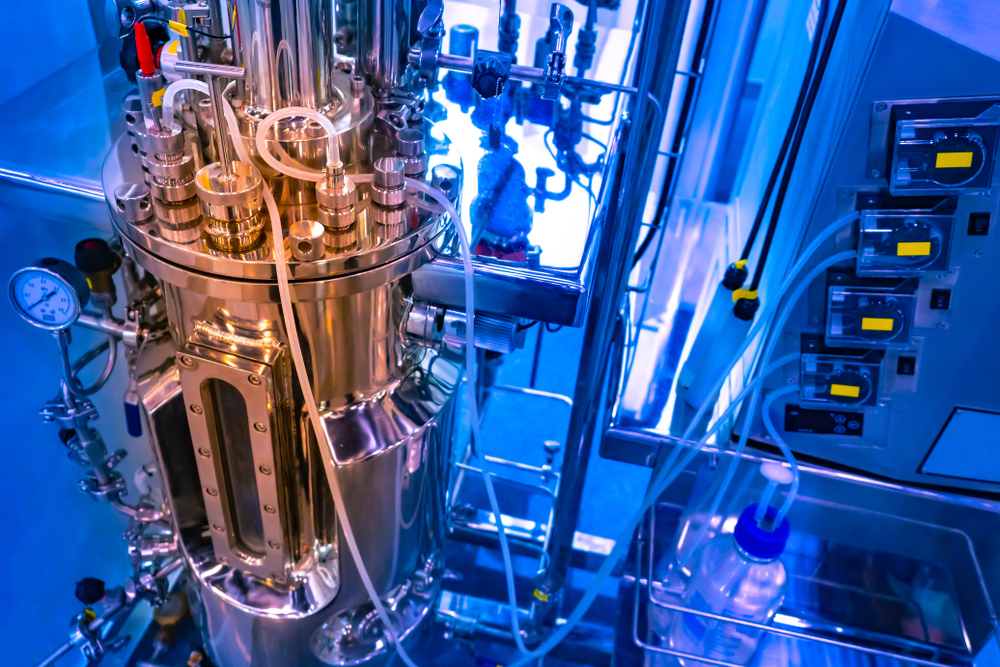
Life science startups will need bioreactors, which are vessels used to cultivate and control the growth of biological cells or organisms. They provide controlled environments for various applications in biotechnology, pharmaceutical research, and industrial production of biological products.
9. Cryogenic Freezer
Cryogenic freezers store biological samples at ultra-low temperatures below -150 degrees Celsius, ensuring long-term preservation for research purposes in fields such as biotechnology, genetics, and regenerative medicine.
10. Lab Balance
Lab balances accurately measure the mass of substances in laboratory settings. They are essential for analytical chemistry, pharmaceutical research, and quality control, ensuring precise and reliable measurements in scientific experiments and procedures.
These are just a few examples, and the specific equipment used can vary depending on the focus of biotech companies. Other important equipment includes incubators, spectrophotometers, electrophoresis systems, and various specialized instruments for specific applications. The choice of equipment depends on the nature of the experiments and analyses conducted in the laboratory.
Fume Hood Integration
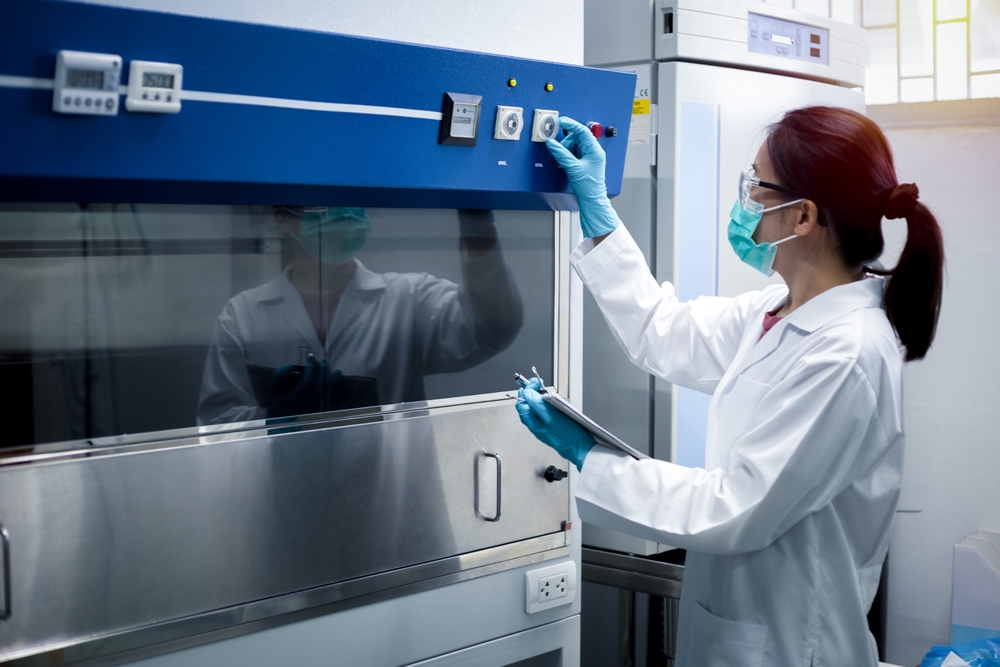
Fume hoods are critical pieces of equipment in biotech labs. They provide a controlled environment to protect researchers from exposure to harmful fumes, vapors, or particulate matter generated during various laboratory procedures.
Integrate them seamlessly with the furniture layout. Ensure that there is sufficient space and proper ventilation for safe chemical handling.
Different types of fume hoods are designed for specific applications. Here are some common types of fume hoods typically installed in biotech labs:
1. General-Purpose Fume Hoods
These are versatile bench-top fume hoods suitable for a wide range of applications, including chemical analyses, sample preparation, and general laboratory work. These hoods are generally placed on a bench-top or above a storage cabinet.
2. Floor Mounted Fume Hoods
Commonly known as Walk-in Fume Hoods, they are used for large apparatus and storage of containers that pose some hazard, but will not fit into an approved storage cabinet.
3. Perchloric Acid Fume Hoods
Specifically designed to handle procedures involving perchloric acid, which is highly corrosive and poses unique safety challenges. Perchloric acid fume hoods typically have enhanced construction materials to resist corrosion.
4. Radioisotope Fume Hoods
Used when working with radioactive materials. These hoods are designed to prevent the escape of radioactive particles and often feature lead lining to provide additional shielding.
5. Laminar Flow Hood
Also known as a tissue culture cabinet, the laminar flow hood is a carefully enclosed bench designed to prevent contamination of semiconductor wafers, biological samples, or any particle-sensitive materials.
6. Low-flow or High-performance Fume Hoods
Engineered to provide adequate containment of hazardous materials with reduced airflow, leading to energy savings. These hoods often meet or exceed industry standards for containment while optimizing energy efficiency and reducing the associated costs.
7. Canopy Hoods
Larger than traditional fume hoods, canopy hoods cover an entire bench or workspace. They are suitable for operations that generate large volumes of fumes or require a broader area of containment.
8. Auxiliary Fume Hoods
These hoods are installed in specific locations within the lab, such as next to specialized equipment, to capture fumes at the source. They complement the general fume hood infrastructure.
When selecting fume hoods for a biotech lab, it’s essential to consider the specific needs of the laboratory, the types of substances handled, and any regulatory requirements. Proper installation, maintenance, and regular testing are crucial to ensuring the effectiveness and safety of fume hoods in the laboratory environment.
Fume Hood Safety Considerations
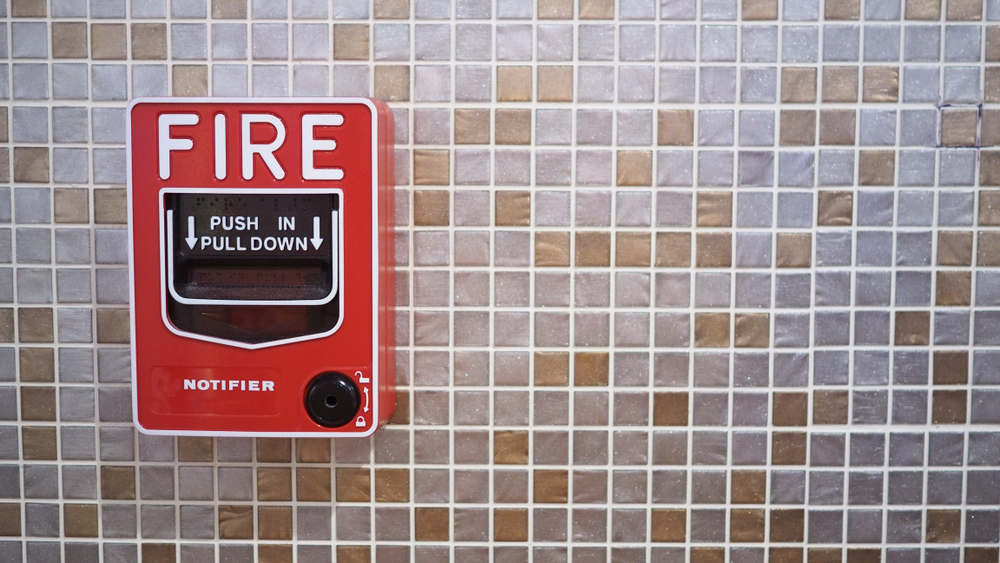
Laboratory fume hoods are potential locations for fires and explosions due to the types of experiments conducted in these units. As such, fume hoods should be located within the laboratory so that in the event of a fire or explosion within the fume hood, exit from the laboratory would not be impeded.
- Laboratory fume hoods should be located away from high-traffic lanes within the laboratory because personnel walking past the sash opening may disrupt the flow of air into the unit and cause turbulence, drawing hazardous fumes into the laboratory.
- Sufficient aisle space should be provided in front of the fume hood to avoid disruption of the work or interference with the operating technician by passing personnel.
- Safety devices such as drench showers, eye wash stations, fire extinguishers, first aid kits, and fire blankets should be located convenient to the fume hood operating personnel and plainly labeled as to their use and function.
The employer is responsible for ensuring that the hood meets satisfactory safety standards.
The following guidelines are provided to help reduce your potential for exposure when working with hazardous materials.
- Plan for conducting experiments.
- Wear appropriate personal protection.
- Verify proper system operation.
- Utilize proper work practices.
Lab Management
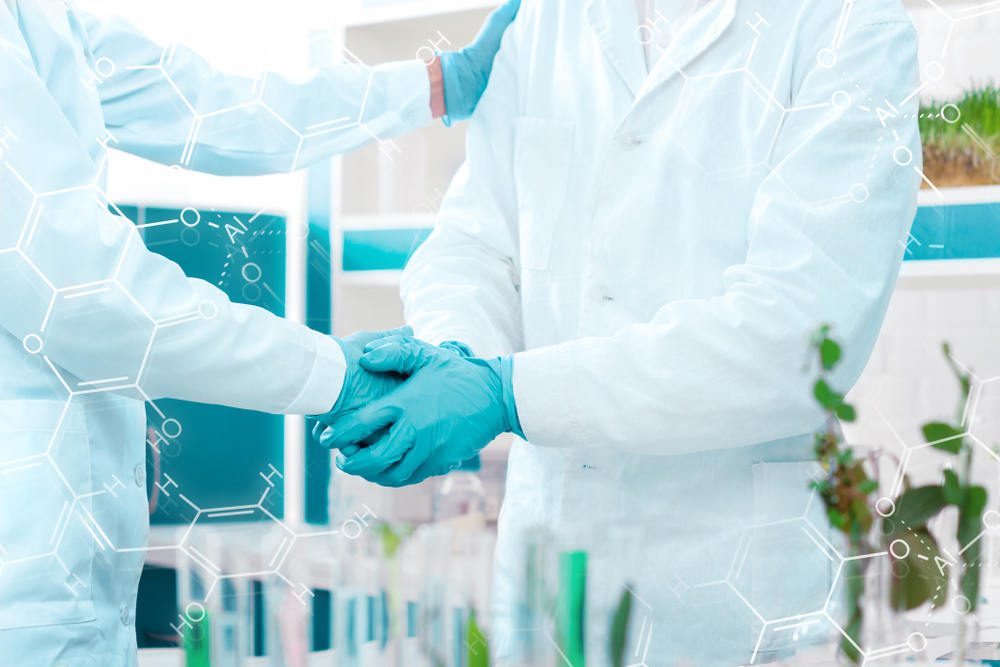
Remember that starting and running a biotech laboratory is a complex endeavor that requires careful planning, dedication, and commitment. However, staying at the forefront of scientific advancements also requires exceptional organizational and managerial skills. Here are some tips for managing startups in the biotech industry.
1. Safety Protocols
Develop and implement strict safety protocols. Ensure that workstations are properly organized to prevent cross-contamination. Provide proper training for lab personnel, and ensure the availability and use of personal protective equipment (PPE). Include safety features in the lab design, such as emergency showers, eye wash stations, and proper ventilation systems.
2. Waste Management
Design an efficient waste management system for the disposal of biological, chemical, and hazardous waste. Follow regulatory guidelines for waste handling and disposal.
3. Supply Chain Management
Establish relationships with reliable providers for reagents, consumables, and equipment. Maintain an organized inventory system to prevent shortages and facilitate easy reordering.
4. Data Management and Documentation
Implement a robust system for data management and documentation for recording and storing experimental data. This includes electronic lab notebooks, data backup procedures, and secure storage. Ensure that the lab design facilitates efficient data recording and ensures compliance with data protection regulations.
5. Consider Intellectual Property

Be mindful of intellectual property considerations for any discoveries or inventions that may arise from your research. Understand the patenting process and take steps to protect your intellectual assets.
6. Security Measures
Implement security measures to safeguard valuable equipment, reagents, and data. This may include access control systems and surveillance.
7. Implement Quality Control Measures
Develop and implement rigorous quality control measures to ensure the reliability and reproducibility of your research results. Regularly calibrate and maintain equipment, and document all processes. This is crucial for maintaining scientific integrity.
8. Build a Competent Team
Assemble a skilled and diverse team of qualified researchers, scientists, and support staff. Collaboration is key in biotech, so ensure that your team members have complementary skills and expertise.
9. Invest in Training
Continuous training is essential in biotech, given the rapidly evolving nature of the field. Provide ongoing education and training opportunities for your team to stay updated on the latest techniques and advancements.
10. Continual Improvement
Embrace a culture of continuous improvement and reaching new milestones. Regularly evaluate and update your lab’s processes, technologies, and methodologies to stay at the forefront of biotech research.
11. Establish Collaboration and Networking
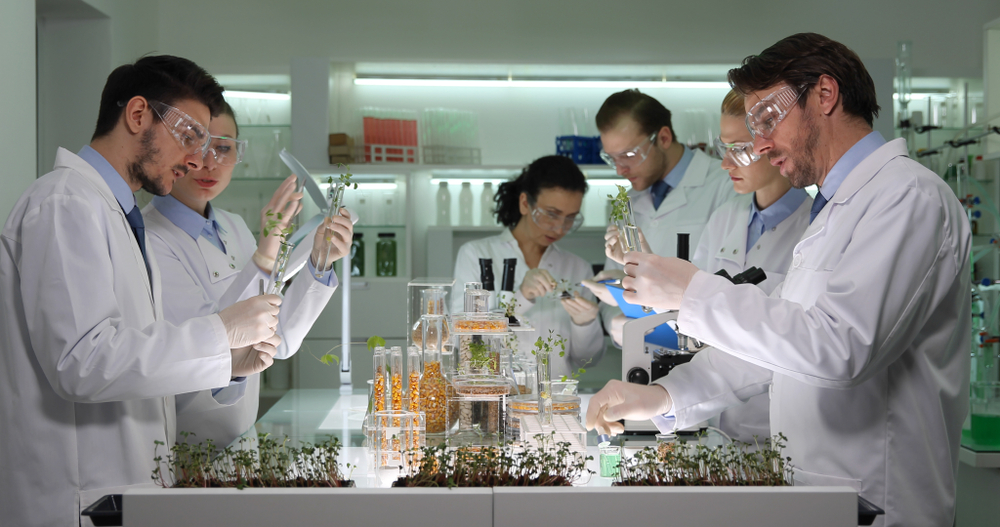
Biotech entrepreneurs should foster collaborations with other research institutions, universities, and industry and university lab partners. This can enhance your laboratory’s capabilities, provide access to shared space, resources, mentoring, and expertise, and facilitate knowledge exchange.
Attend conferences, workshops, and networking events within the biotech community. Stay informed about the latest trends, technologies, and discoveries in the field.
12. Environmental Sustainability
Consider environmentally friendly practices in your lab design and daily operations. This may include waste reduction, energy-efficient equipment, eco-friendly disposal methods, and other options to protect the ecosystem.
Launching a wet lab in the biotech industry requires a comprehensive approach that encompasses scientific, regulatory, and organizational considerations. Collaborate with experienced professionals, stay informed about industry trends, and be adaptable to changes in the field.
Conclusion
In the dynamic intersection of science, innovation, and business, the journey of starting a wet lab in the biotech industry is a testament to the pursuit of knowledge and transformative discoveries. From the initial spark of an idea to the hum of state-of-the-art equipment, the establishment of a biotech lab is a multidimensional endeavor that demands meticulous planning, strategic decision-making, and a commitment to excellence.
As startups embark on this challenging yet rewarding venture, the importance of a well-designed wet lab cannot be overstated. The integration of cutting-edge fume hoods and lab furniture not only enhances safety and functionality but also sets the stage for groundbreaking research.
With the right blend of business acumen, financial support, and a thoughtfully designed laboratory space, startups in the biotech industry can position themselves for success. By fostering an environment where scientific curiosity meets entrepreneurial spirit, they can shape the future of biotechnology.




